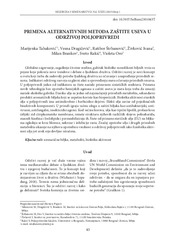Приказ основних података о документу
Application of alternative methods of crop protection in sustainable agriculture
Primena alternativnih metoda zaštite useva u održivoj poljoprivredi
| dc.contributor | Babić, Vojka | |
| dc.creator | Tabaković, Marijenka | |
| dc.creator | Dragicevic, Vesna | |
| dc.creator | Štrbanović, Ratibor | |
| dc.creator | Zivkovic, Ivana | |
| dc.creator | Brankov, Milan | |
| dc.creator | Rakić, Sveto | |
| dc.creator | Oro, Violeta | |
| dc.date.accessioned | 2023-07-26T11:22:22Z | |
| dc.date.available | 2023-07-26T11:22:22Z | |
| dc.date.issued | 2023 | |
| dc.identifier.issn | 0354-5881 | |
| dc.identifier.issn | 2406-209X | |
| dc.identifier.uri | http://rik.mrizp.rs/handle/123456789/1170 | |
| dc.description.abstract | Globalno zagrevanje, zagađenje životne sredine, gubitak biološke raznolikosti biljnih vrsta su pojave koje pokreću nove trendove i debate o ljudskom društvu. Održivi razvoj je novi koncept u svetu koji treba da zadovolji potrebe ljudskog društva uz očuvanje i unapređenje prirodnih resursa. Indikatori održivog razvoja su glavni alati u sprovođenju mera očuvanja prirodnih resursa. U poljoprivredi jedan od indikatora su štete nastale primenom sintetičkih sredstava. Primena novih tehnologija bez upotrebe hemijskih agenasa u zaštiti useva je mera koja treba da umanji nastale ekološke gubitke. Etarska ulja su jedan od najznačajniji prirodnih metabolita, sekundarni produkti aromatičnih biljaka koji se uspešno koriste kao biopesticidi. Biološka aktivnost etarskih ulja u poljoprivredi ima antimikrobno i herbicidno dejstvo. Efekti ulja zavise od pojedinačnih bioaktivnih komponenti. U prirodi igraju važnu ulogu u zaštiti biljaka kao antibakterijski, antivirusni, antifungalni, insekticidni agensi. Kod većine korova, ulja kao tipični lipofili, prolaze kroz ćelijski zid citoplazmatske membrane, remete strukturu njihovih različitih slojeva polisaharida, masnih kiselina i fosfolipida i permeabiliziraju ih. Štete od primene eteričnih ulja (EU) na biljkama ogledaju se kroz hloroze, nekroze i inhibicije rasta. Značaj upotrebe ulja i drugih prirodnih metabolita ukazuje na njihovu upotrebnu vrednost u održivoj poljoprivredi iako fiziološka aktivnost ulja još uvek nije dovljno istražena. | sr |
| dc.description.abstract | Environmental problems such as global warming, pollution, and the decline of plant species biodiversity are leading to new social trends and discussions. A relatively new idea of global sustainable development aims to meet societal demands while protecting and enhancing natural resources. The main tools used in the implementation of natural resource protection measures are sustainable development indicators. One of these indicators is the damage caused by the use of synthetic chemicals in agriculture. In Serbia, agriculture is an important sector of the economy with different levels of technological progress, from extensive to intensive. The degree of pollution and its impact on the environment varies according to agricultural production. The challenges faced by modern agricultural production in conditions of technological progress have led to the intensification of production, but have also caused concern about maintaining the natural balance of cultivated land and product quality. The application of innovative technologies for crop protection without the use of chemical agents is a step that should reduce the environmental damage caused. Among the most important natural metabolites and secondary products of aromatic plants used as biopesticides are essential oils. The biological activities of essential oils (EOs) in agriculture have antimicrobial and herbicidal effects. The various bioactive components of the oil determine its action. In nature, they play an important role in protecting plants from bacteria, fungi, viruses and insects. In most weeds, the oils penetrate the cytoplasmic membrane of the cell as typical lipophiles and cause its multilayers of polysaccharides, fatty acids and phospholipids to lose their structure and become permeable. Chlorosis, necrosis, and growth inhibition are symptoms of damage caused by the application of essential oils to plants. Although the physiological effects of the oil are not yet well studied, the importance of its use and other natural metabolites indicates its value for sustainable agriculture | sr |
| dc.language.iso | sr | sr |
| dc.language.iso | en | sr |
| dc.publisher | Belgrade : Serbian Association of Plant Breedings and Seed Producers | sr |
| dc.relation | info:eu-repo/grantAgreement/MESTD/inst-2020/200040/RS// | sr |
| dc.relation | info:eu-repo/grantAgreement/MESTD/inst-2020/200010/RS// | sr |
| dc.relation | info:eu-repo/grantAgreement/MESTD/inst-2020/200116/RS// | sr |
| dc.rights | openAccess | sr |
| dc.rights.uri | https://creativecommons.org/licenses/by/4.0/ | |
| dc.source | Selekcija i semenarstvo časopis | sr |
| dc.subject | aromatične biljke | sr |
| dc.subject | metaboliti | sr |
| dc.subject | biološka aktivnost | sr |
| dc.subject | aromatic plants | sr |
| dc.subject | metabolites | sr |
| dc.subject | biological activity | sr |
| dc.title | Application of alternative methods of crop protection in sustainable agriculture | sr |
| dc.title | Primena alternativnih metoda zaštite useva u održivoj poljoprivredi | sr |
| dc.type | article | sr |
| dc.rights.license | BY | sr |
| dc.citation.volume | 29 | |
| dc.citation.issue | 1 | |
| dc.citation.spage | 43 | |
| dc.citation.epage | 50 | |
| dc.identifier.doi | 10.5937/SelSem2301043T | |
| dc.identifier.fulltext | http://rik.mrizp.rs/bitstream/id/6216/bitstream_6216.pdf | |
| dc.type.version | publishedVersion | sr |


